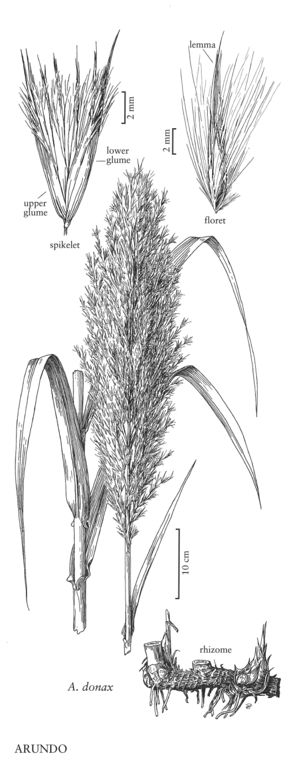| Taxon | Illustrator ⠉ | |
|---|---|---|
 | Arundo donax | Hana Pazdírková Linda A. Vorobik |
Plants perennial; rhizomatous, rhizomes short, usually more than 1 cm thick. Culms 2-10 m tall, 1-3.5 cm thick, usually erect, occasionally pendant from cliffs; nodes glabrous; internodes hollow. Leaves cauline, conspicuously distichous, glabrous; sheaths open, longer than the internodes; ligules membranous, shortly ciliate; blades flat or folded, margins scabrous. Panicles terminal, plumose, silvery to purplish. Spikelets laterally compressed, with 1-several florets; rachilla segments glabrous; disarticulation above the glumes and between the florets. Glumes longer than the florets, 3-5-veined; lemmas pilose, hairs not papillose-based, 3-7-veined, apices entire or minutely awned; paleas shorter than the lemmas, 2-veined; anthers 3. x = 12.
Distribution
Del., W.Va., Pacific Islands (Hawaii), Fla., Tex., La., Tenn., N.C., S.C., Nev., Va., Calif., Puerto Rico, Virgin Islands, Ala., Ark., Ill., Ga., Ariz., N.Mex., Md., Okla., Utah, Mo., Kans., Miss., Ky.
Discussion
Arundo, a genus of three species, grows throughout the tropical and warm-temperate regions of the world. Only one species has been introduced to the Western Hemisphere.
Arundo is similar to, but usually larger than, Phragmites, a much more common genus in North America. In addition, Arundo, but not Phragmites, has a wedge-shaped, light to dark brown area at the base of its blades.
Selected References
None.
Lower Taxa
"decumbent" is not a number.